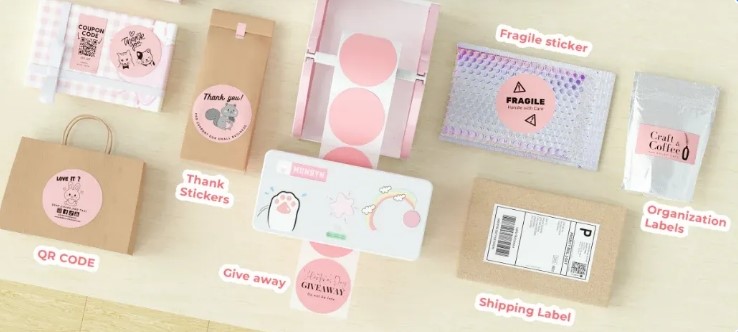Why Thermal Labels Are Essential for Organization, Shipping, and Inventory in Today’s World

In an age where speed, accuracy, and organization are more important than ever, efficient labeling systems have become essential for both personal and professional use. Whether you’re managing a busy warehouse, running an online business, or simply trying to keep your home office in order, using thermal labels can make a significant difference.
These labels offer a reliable, cost-effective way to create clear, durable tags for everything from packages and inventory to folders and storage bins. With the growing demand for smart, practical tools, thermal labels have earned their spot as one of the most useful supplies across many industries and environments.
What Are Thermal Labels?
Thermal labels are adhesive labels printed using heat instead of ink or toner. There are two primary types of thermal printing used to create these labels:
- Direct Thermal Labels: These are made with specially coated paper that reacts to heat. The printer applies heat directly to the paper, producing a printed image. They’re ideal for short-term use, such as shipping labels and receipts.
- Thermal Transfer Labels: These labels require a ribbon coated with ink, which is melted onto the label surface by a heated print head. They are more durable and suitable for long-term labeling or labels exposed to sunlight, moisture, or abrasion.
Both types are used widely depending on the task at hand, and they each offer distinct benefits depending on the application.
Practical Uses of Thermal Labels
Thermal labels are versatile, and their uses extend far beyond shipping. Here are some of the most common and practical ways they’re used in day-to-day operations:
1. Shipping and Logistics
In warehouses, fulfillment centers, and retail shipping operations, thermal labels are vital. They’re used to print address labels, tracking barcodes, and packing slips. Since they’re quick to produce and easy to scan, they keep the shipping process moving efficiently. They’re also smudge-proof and adhesive enough to stay put during transit.
2. Retail and Price Tagging
Thermal labels are frequently used in retail environments for product pricing, shelf tags, and promotional signage. Direct thermal printing is especially helpful for temporary sales or rotating inventory. Stores can update and print labels on demand without relying on third-party printing services.
3. Inventory Management
Keeping track of inventory can be time-consuming without the right tools. With thermal labels, products, storage bins, and shelves can be clearly tagged, making it easier for employees to identify stock, perform audits, and manage reorder points. Thermal transfer labels are particularly useful for long-term labeling that needs to withstand environmental wear and tear.
4. Office and Home Organization
Thermal labels aren’t limited to commercial use. Many people now use them at home to label files, storage containers, pantry items, and personal belongings. A neatly labeled environment makes it easier to find what you need and promotes better productivity and time management.
5. Healthcare and Laboratories
In hospitals, clinics, and labs, labeling is critical for patient safety and accurate record-keeping. Thermal labels are used for specimen containers, medication bottles, wristbands, and medical records. Their clarity and resistance to fading or smearing make them ideal for this sensitive environment.
6. Food Service and Packaging
Restaurants, bakeries, and food manufacturers use thermal labels for date labeling, ingredient lists, and packaging information. Some thermal labels are designed to withstand cold storage or moisture, making them suitable for use in fridges and freezers.
Advantages of Using Thermal Labels
There are several compelling reasons why thermal labels are widely adopted across different industries:
- Cost-Effective: Since direct thermal printing doesn’t require ink or toner, operating costs are lower over time. You also avoid the mess and hassle of ink cartridge replacements.
- Time-Saving: Thermal printers produce labels quickly and efficiently, which is especially valuable in fast-paced environments like shipping departments or retail stores.
- Clarity and Scannability: Thermal labels produce crisp, clear prints that are easily scannable. This is especially important for barcode-based systems.
- Low Maintenance: With fewer moving parts and no ink systems to worry about, thermal printers are typically low maintenance and long-lasting.
- Environmentally Friendly Options: Many thermal labels are now available in eco-conscious formats, such as BPA-free or recyclable materials, helping users reduce their environmental footprint.
Important Considerations Before Choosing
When selecting thermal labels for your needs, a few key factors should be considered:
- Label Lifespan: For short-term uses, direct thermal labels are a great choice. If the label needs to last longer or withstand harsh conditions, thermal transfer is better suited.
- Label Size and Type: Make sure the labels are compatible with your printer and appropriate for the task—be it small barcode labels or large shipping tags.
- Adhesive Strength: Depending on the surface you’re labeling, you may need permanent, removable, or freezer-grade adhesives.
- Environmental Exposure: Will the labels be exposed to sunlight, water, or high temperatures? Choose materials accordingly.
Final Thoughts
Thermal labels may seem like a small part of your daily routine, but they have a powerful impact on efficiency and organization. Whether you’re labeling products for sale, shipping orders, organizing documents, or tagging storage containers, they offer a fast, clean, and cost-effective solution.With applications ranging from home organization to complex logistics systems, thermal labels have become an essential part of how we manage our spaces and processes.




